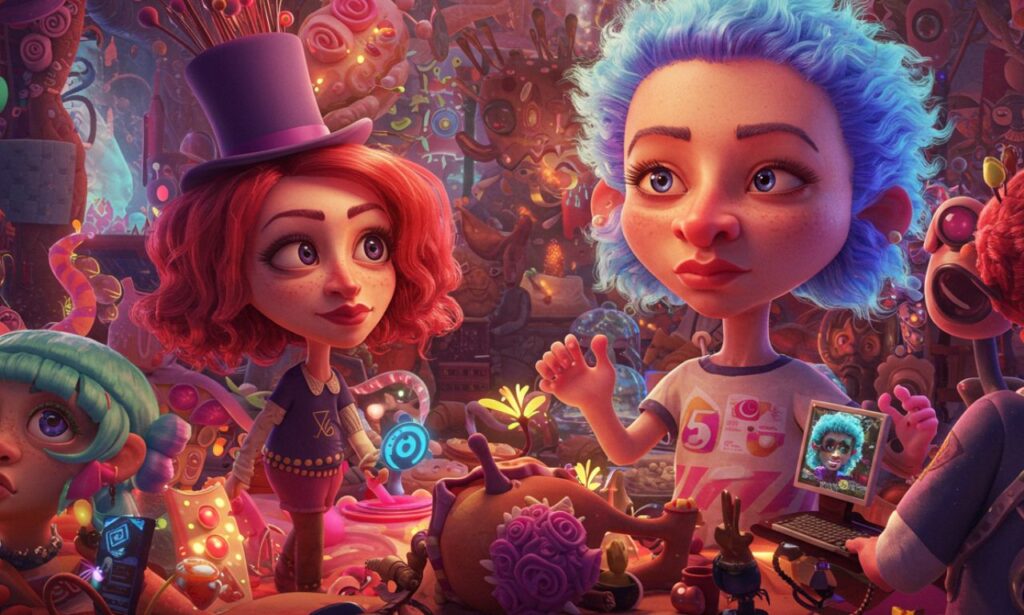Caricatronchi is an emerging digital-art style that merges caricature with fragmented, surreal elements—often enhanced by AI and bold distortion. It plays with exaggerated features, broken forms, vibrant or glitch art palettes, and mixed media to craft portraits or avatars that feel more expressive than realistic.
Caricatronchi Origins & Etymology
The name “Caricatronchi” appears to come from combining caricature (the tradition of distorting appearance for effect) with “tronchi,” possibly Italian for fragments or trunks/chunks. Together the term suggests art made of fractured parts or distorted components.
It seems to have arisen recently—viral via social media, AI-art communities, digital artists experimenting with identity and style. Its roots draw both from classic caricature traditions and digital/surreal visual art.
Caricatronchi Aesthetic & Key Features
Distinct Visual Traits of Caricatronchi
-
Exaggerated Facial or Body Features — oversized eyes, distorted facial proportions, elongated limbs or necks.
-
Fragmented or Glitched Composition — faces or forms broken into shards, segments; sometimes masked overlays or abstraction.Bold, Surreal Colors & Texture — bright or unlikely color palettes, neon or pastel tones, glitch effects, texture overlay for emotional or symbolic effect Symbolism & Emotional Depth — beyond humor, many pieces express identity, emotional tension, self-critique, internal contradictions.
Why Caricatronchi Is Gaining Popularity
Cultural & Technological Drivers
-
Digital Identity & Authenticity: In an age of polished filters, curated social media personas, Caricatronchi offers rawness, imperfection, and a way to express self beyond standard avatars. AI Art Tools Becoming Accessible: Tools like Midjourney, Lensa, Artbreeder, etc., let creators experiment easily—generating surreal visuals then editing or remixing. Lower barrier to entry.
-
Social Media & Meme Culture: Visual-sharing platforms amplify striking images; people experiment with identity or humor, sharing caricatured selfies or avatars in challenges. Caricatronchi fits well into viral content. Therapeutic or Expressive Value: Artists and non-artists alike use distortion, exaggeration & surreal visuals to express inner states, critique norms, or explore identity issues.
Caricatronchi in Practice: How It’s Used
Applications & Use-Cases
-
Social Media Avatars & Profile Art — people replace selfies with Caricatronchi-style portraits for uniqueness.
-
NFTs / Digital Collectibles — surreal portraits or stylized pieces get minted as digital art, often trading in platforms valuing novelty and uniqueness.
-
Branding & Visual Identities — experimental brands or personal brands use Caricatronchi style in logos, merch, or promotional art to stand out.
-
Art Therapy & Creative Expression — compressing identity, fears, or emotions into distorted visuals helps some people explore anxiety, identity fragmentation or self-image.
How to Create Caricatronchi Art
Step-by-Step Guide
-
Choose Your Base Image or Sketch
Use a selfie or portrait sketch. You want something recognizable to distort. -
Select Tools
-
AI generators (Midjourney, Lensa, etc.) to produce surreal versions
-
Digital editors (Photoshop, Procreate, Illustrator) to refine, add texture, layers, glitched effects.
-
-
Distort & Fragment
Exaggerate features (eyes, mouth, head shape), break up the form into sections, overlay masks or geometric shapes. -
Color & Texture
Choose expressive color; apply glitch effects, texture overlays, pastel/neon contrasts, or layered visuals for depth. -
Symbolic Add-Ons
Include surreal props or motifs—wires, clocks, disjointed elements that speak to identity, technology, time, etc. -
Finalize and Share
Output at sufficient resolution; share on platforms; sometimes animate small glitches or interactive features.
Challenges, Criticisms & Ethical Considerations
Things to Watch Out For
-
Cultural Sensitivity: Exaggeration can cross lines; ensure caricature doesn’t stereotype, mock, or offend particular groups.
-
AI Bias or Over-Replicating Styles: If using AI prompts, you may inadvertently perpetuate biased representations or replicate popular Caricatronchi tropes without originality.
-
Copyright & Ownership: Who owns the generated art? The AI tool? The user? Be clear if you plan commercial use.
-
Identity Misuse / Deepfake Risks: If using real people’s likenesses heavily distorted, misuse or misrepresentation could arise.
Caricatronchi Trends & What’s Nex
-
Interactive & Animated Caricatronchi: Moving from static images to animated versions—glitch flickers, morphing faces.
-
Augmented Reality (AR) Filters: Filters in social apps that let users present live Caricatronchi effects on their own faces.
-
Digital Galleries & Exhibits: Virtual shows or NFT spaces showcasing Caricatronchi work.
-
Merch & Fashion Integration: Printed art, clothing, accessories carrying Caricatronchi themes.
-
Creative Platforms Embracing the Style: More tools adding templates or filters specifically for this aesthetic.
Why Caricatronchi Matters in 2025
Caricatronchi reflects broader cultural shifts: people want more authenticity, less polished perfection. It gives a way to express complexity, fragmentation, identity in visual form. As AI becomes more accessible, the boundary between clean digital personas and inner self smudges—and Caricatronchi is part of that conversation. It’s a way art can respond to the digital age: imperfect, glitchy, emotional, individual.
How to Engage with Caricatronchi Thoughtfully
-
Support original artists—follow credit, avoid copying without consent.
-
If using AI, credit tools and resolve issues of ownership.
-
Experiment with the style but add your own voice—don’t just replicate what’s trending.
-
Be mindful of how your portrayal of identity or distortion might impact others—think about sensitivity.
-
Use it as self-expression, not concealment—letting its flaws and oddities be part of the story.
Conclusion
Caricatronchi is more than a trend—it’s a mirror for what many feel in the digital age: fragmented, expressive, imperfect, bold. It blends caricature’s humor with surreal and broken forms, painted in neon, glitch, and raw emotion. Artists and everyday users alike are embracing it to show who they are beyond polished selfies.
If you’re curious, try making your own Caricatronchi—play with prompts, distortions, colors. See what parts of your identity or emotion you can express. In a world saturated with perfection, sometimes what stands out isn’t flawlessness but authenticity.






